Abstract
Context:
There is a lacuna of studies on Attention Deficit Hyperactivity Disorder (ADHD) in the Indian context.
Aims:
(i) To identify the prevalence of ADHD in primary school children, (ii) To identify the gender difference in the prevalence of ADHD, (iii) To compare the distribution of ADHD among different socioeconomic status, (iv) To identify the presence of any co-morbid factors associated with ADHD.
Settings and Design:
This is a cross sectional study of school aged children selected from four different schools in Coimbatore district.
Materials and Methods:
Seven hundred seventy children aged between 6 and 11 years were selected from four schools in Coimbatore district after obtaining informed consent from their parents. The presence of ADHD was assessed by using Conner's Abbreviated Rating Scale (CARS) given to parents and teachers. The children identified as having ADHD were assessed for the presence of any co-morbid factors by administering Children's Behavioural Questionnaire (CBQ) to the teachers and Personal Information Questionnaire to the parents.
Statistical Analysis:
Statistical Product and Service Solutions (SPSS) 10 software, Mean and Standard Deviation, and student's t test were used for statistical analysis.
Results:
The prevalence of ADHD among primary school children was found to be 11.32%. Prevalence was found to be higher among the males (66.7%) as compared to that of females (33.3%). The prevalence among lower socio-economic group was found to be 16.33% and that among middle socio-economic group was 6.84%. The prevalence was highest in the age group 9 and 10 years.
Conclusion:
The present study shows a high prevalence of ADHD among primary school children with a higher prevalence among the males than the females.
Keywords: Attention deficit hyperactivity disorder, conner's abbreviated rating scale, prevalence, socio-economic status
INTRODUCTION
Attention Deficit Hyperactivity Disorder (ADHD) is highly prevalent in children worldwide and its prevalence in adults is increasingly recognized.[1] The major limitations in the previous studies are that the identification of ADHD was made from samples through clinically referred cases and not from the community, small sample size, failure to use definitive diagnostic criteria. There is only a limited source of information regarding the prevalence of ADHD in the Indian context. Hence, the current study aims at selecting primary school children from a community sample. The objectives of the study were (i) To identify the prevalence of Attention Deficit Hyperactivity Disorder (ADHD) in primary school children. (ii) To identify the gender difference in the prevalence of ADHD. (iii) To compare the distribution of ADHD among different socioeconomic status. (iv) To identify the presence of any co-morbid factors associated with ADHD.
MATERIALS AND METHODS
Sample
The sample consisted of 770 primary school children aged between 6 and 11 years selected from four different schools in Coimbatore District.
Tools
-
(a)
Conner's Abbreviated Rating Scale (CARS) This is a rating scale that consists of several behavioral parameters for the diagnosis of ADHD. This was rated by the parents and the teachers
-
(b)
Children's Behavior Questionnaire (CBQ, Rutter) This questionnaire was given to the teachers of the children identified in the study as having ADHD. It consists of two separate questionnaires, namely (i) CBQ-A, (ii) CBQ-B. CBQ-A is used for assessing their academic performance, reading and writing difficulties, and need for psychiatric guidance, and CBQ-B is used for assessing their behavioral difficulties, if any
-
(c)
Personal Information Questionnaire This is a questionnaire designed for the current study. It was given to the parents of the children identified in the study as having ADHD to elicit drug history and assess social behavior, academic performance and family history of ADHD or any other psychiatric disorder, and presence of recent stressor, etc., if any.
Methodology
Approval from Institutional Human Ethical Committee (IHEC) was obtained before conducting the study. This is a cross sectional study involving 770 primary school children aged between 6 and 11 years (1st std. to 5th std.) selected on a random basis from four different schools in Coimbatore district. After obtaining permission from the school Principals, the written informed consent form was given to the parents through the children. Parents of 635 children gave consent for allowing their children to participate in the study. This sample consisted of 324 males and 311 females. The sample was also broadly divided into two groups based on their socio-economic status: (a) 300 children belonging to lower socio-economic status selected from a government-aided school with Tamil as its medium of instruction, (b) 335 children belonging to middle socio-economic status selected from three different schools, which followed English as their medium of instruction. Thirty children were chosen from each standard in both the groups selected from their class attendance registers on a random basis with equal number of boys and girls. This was done to avoid selection bias. All the tools were translated into Tamil and translated back to English for ensuring correct translation. This was done for the convenience of parents and teachers. The flow chart below schematically represents the methodology of sample selection [Figure 1].
Figure 1.
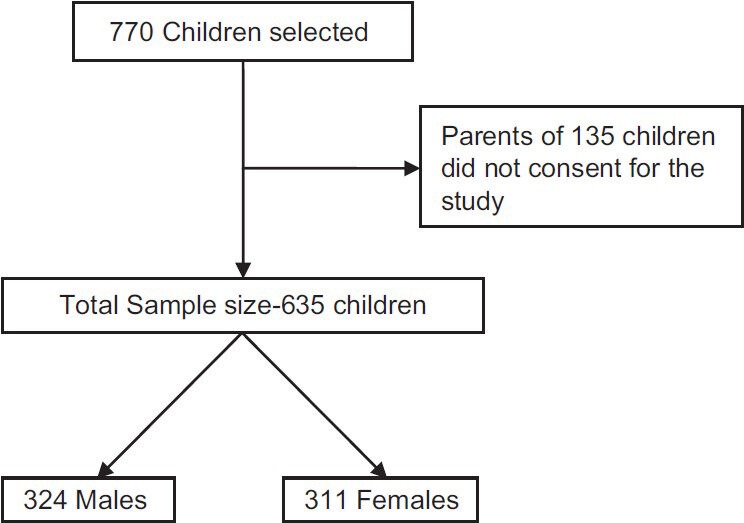
Schematic representation of sample selection
CARS was given to the teachers and to the parents of the children. Based on the score obtained as per the teachers rating presence of ADHD was identified. For the children identified in the study as having ADHD, the CBQ A and B were given to the teachers and Personal Information Questionnaire to the parents to identify the co-morbid conditions. CARS was given to both parents and teachers to compare the teacher's and parent's rating score. Statistical Product and Service Solutions (SPSS) 10 software, Mean and Standard Deviation and student's t test were used for statistical analysis.
RESULTS
Prevalence
Out of 635 children studied, 72 children were found to have ADHD based on the CARS score as per the teachers rating. Prevalence of ADHD among primary school children was 11.33% as shown in Figure 2.
Figure 2.
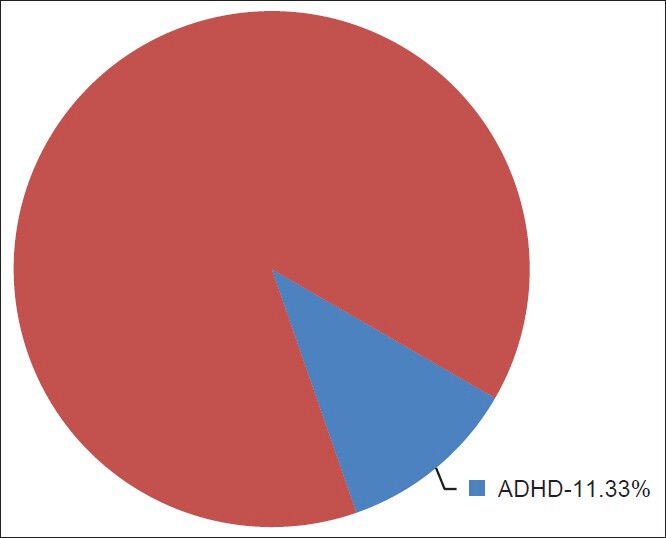
Prevalence of ADHD in primary school children
Age-wise stratification of ADHD
Children with ADHD were also stratified on the basis of their age into six groups. The prevalence rate in each age group was identified which is shown in the Table 1 and Figure 3. Prevalence of ADHD was found to be highest among the children of age 9 and 10 years.
Table 1.
Distribution of ADHD among different age groups
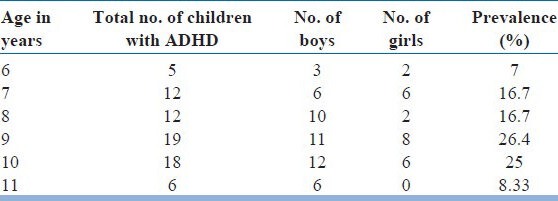
Figure 3.
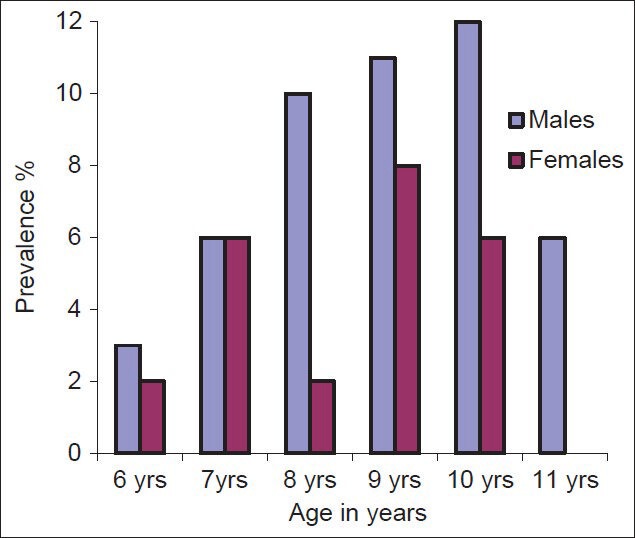
Distribution of ADHD among different age groups in males and females
Gender difference
ADHD was more prevalent in the males than in the females. Total no. of males selected were 324, 48 of them had ADHD. Prevalence of ADHD in the males was 14.81%. Total no of females selected were 311, 24 among them had ADHD. Prevalence of ADHD in the females was 7.71%. Among the 72 children identified as having ADHD, 66.7% (48) were males and 33.3% (24) were females. This is shown in Figure 4.
Figure 4.
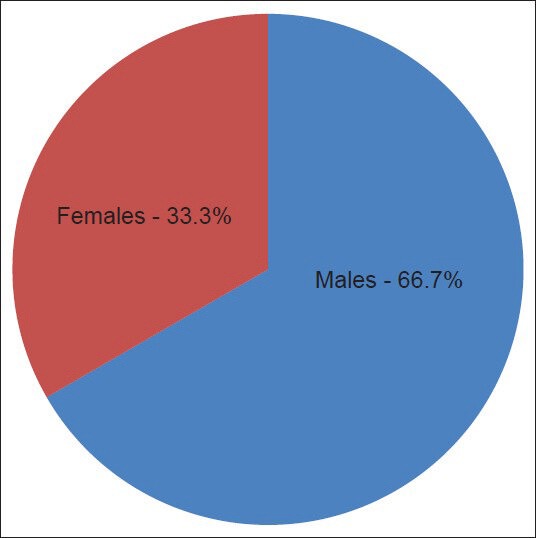
Prevalence of ADHD in males and females
Co-morbidity in ADHD
The co-morbid conditions associated with ADHD were identified as poor academic performance, reading difficulty, writing difficulty, behavioral difficulties, and poor social behavior. Based on the CBQ A score the academic performance of the children identified as having ADHD was assessed. The academic performance was poor in 33.3% (24 children) and reading difficulty was present among 15. 3% (11 children) and similarly writing difficulty was also present in 15. According to the teachers 19.4% (14 children) needed psychiatric guidance.
Based on the CBQ B score, 36.11% (26 children) had significant associated behavioral difficulties. These findings are depicted in Table 2.
Table 2.
Co-morbidity in ADHD

Based on the data obtained from the Personal Information Questionnaire filled by the parents, of the 72 children with ADHD recent illness was present in 31.94% (23 children) and 22.22% (16 children) fall ill frequently. Family history of ADHD or other psychiatric illness was present in 8.33% (six children). An ongoing or a recent stressor in the family that could have disturbed the child was present in 6.94% (five children). Poor social behavior with relatives was present in 11.1% (nine children) and poor social behavior with friends was present in 12.5% (nine children) of which the latter is included in Table 2, which shows the prevalence rates of the above mentioned co-morbid conditions But these findings were not highly significant.
ADHD and socio-economic status
There was a significant difference in the prevalence of ADHD between the children belonging to lower and middle socio-economic status. Out of 300 children selected from the lower socio-economic status, 49 had ADHD (16.33%) and 335 children were selected from the middle socio-economic status of which 23 had ADHD (6.86%) as shown in Figure 5. Chi-square test indicated this difference to be highly significant (P<0.001).
Figure 5.
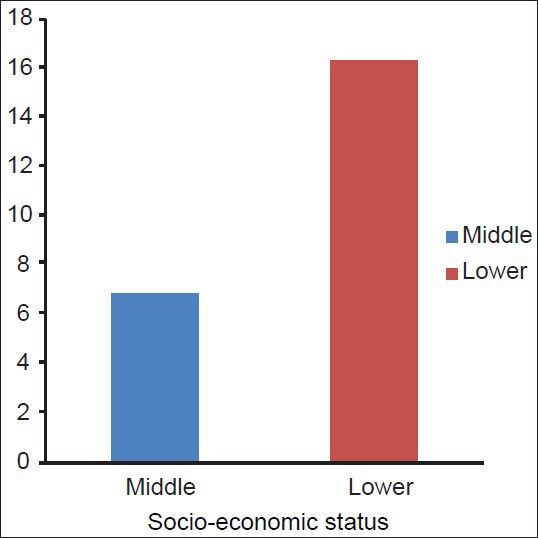
ADHD and socio-economic background
DISCUSSION
The prevalence of ADHD in the community based sample was found to be 11.33%. This is consistent with that of several studies which showed a wide range of prevalence rates between 2% and 17%.[2] There was a significant difference in the prevalence of ADHD between the males and the females, the ratio being 3:1. This finding is similar to that of previous studies which identified a similar gender difference with the ratios ranging from 10:1 in clinically referred sample and 3:1 in a community sample.[3]
There was a maximum prevalence of ADHD in the children aged 9 and 10 years. This finding is not consistent with the several previous studies which have identified a higher prevalence of ADHD among children aged lesser than seven years.[4] There was a significant difference between the CARS Teacher's and Parent's rating score, the teacher's score being higher than that of the parents. This is contradictory to another study which found that the Teacher's and the Parent's scoring rates were similar.[5] This finding may be due to the fact that children spend a greater time in the school and the teachers may observe the children's behavior more intensely and parents may fail to identify the presence of ADHD in their children due to lack of awareness about the symptoms of ADHD.
The co-morbid conditions associated with ADHD were identified as poor academic performance, behavioural difficulty, reading difficulty, writing difficulty.
Other studies conducted in the past also found out that reading disability was frequently co-morbid with ADHD.[6] In outpatient clinics 39% of ADHD demonstrated a specific reading difficulty.[6] Of the children with ADHD, 20 to 25% meet the criteria for learning disorder but learning disorder appears to be independent of ADHD.[7]
No significant association between the drug history and the occurrence of ADHD could be identified. An overall of 8.33% of the children with ADHD had a family history of ADHD or other psychiatric condition. This result is also similar to the previous studies which found that ADHD runs in families.[8,9] This adds to the familial nature of the disease.
Behavioral difficulties were found in 36.11% of the children with ADHD. The teachers found the condition of 19.44% of the ADHD children to be so disturbed that they needed psychiatric guidance. And these children had no previous visit to a psychiatry clinic.
This study has also identified a significant difference in the prevalence of ADHD between the children from lower and those from the middle socio-economic status. This strengthens the fact that the poor socio-economic background is one of the important risk factors for the development of ADHD.[10]
ADHD is a condition which is almost always associated with poor academic performance. Several studies have revealed that the development of anti-social personality as co-morbid with ADHD. Early identification and intervention of this multi factorial neuro-psychiatric condition in the children will help the children improve their academic performance and prevent the development of co-morbid conditions.
Several studies have identified the prevalence of ADHD. The major limitation of these studies was that they involve a sample consisting of clinically referred cases. The advantages of the current study over the previous ones are that
It overcomes the above limitation as it consists of community sample
Selection of larger sample from four different schools including a wider age group of children aged between 6 and 11 years makes the sample more representative. This wider sample also enables us to compare the prevalence rates among different ages and to study the age wise distribution of ADHD.
ADHD is a highly prevalent condition among children. This study indicates the importance of early identification and thus helping in early intervention of this disorder.
Footnotes
Source of Support: Indian Council of Medical Research
Conflict of Interest: None declared.
REFERENCES
- 1.Faraone SV, Seargeant J, Gillberg C, Biederman J. The world wide prevalence of ADHD: Is it an American condition? World Psychiatry. 2003;2:104–13. [PMC free article] [PubMed] [Google Scholar]
- 2.Scahill L, Schwab-Stone M, Merikangas KR, Leckmaz JF, Zhang H, Kasl S. Psychosocial and clinical correlates of ADHD in a community sample of school-age children. J Am Acad Child Adolesc Psychiatry. 1999;38:976–84. doi: 10.1097/00004583-199908000-00013. [DOI] [PubMed] [Google Scholar]
- 3.Biederman J, Mick E, Faraone SV, Braaten E, Doyle A, Spencer T, et al. Influence of gender on attention deficit hyperactivity disorder in children referred to a psychiatric clinic. Am J Psychiatry. 2002;159:36–42. doi: 10.1176/appi.ajp.159.1.36. [DOI] [PubMed] [Google Scholar]
- 4.Singhi P, Malhi P. Attention deficit hyperactivity disorder in school aged children: Approach and principles of management. Indian Pediatr. 1998;35:989–99. [PubMed] [Google Scholar]
- 5.Willcutt EG, Pennington BF. Comorbidity of reading disability and attention deficit/hyperactivity disorder: Differences by gender and subtype. J Learn Disabil. 2000;33:179–91. doi: 10.1177/002221940003300206. [DOI] [PubMed] [Google Scholar]
- 6.Gerald JA, Barry DG. Co-morbidity of ADHD and reading disability among clinic-referred cases. J Abnorm Child Psychol. 1990;18:1573–2835. doi: 10.1007/BF00919454. [DOI] [PubMed] [Google Scholar]
- 7.Pliszka SR. Comorbidity of attention deficit/hyperactivity disorder with psychiatric disorder: An overview. J Clin Psychiatry. 1998;59:50–8. [PubMed] [Google Scholar]
- 8.Faraone SV, Doyle AE, Mick E, Biederman J. Meta-analysis of association between the 7-repeat allele of the dopamine d(4) receptor gene and attention deficit hyperactivity disorder. Am J Psychiatry. 2001;158:1052–7. doi: 10.1176/appi.ajp.158.7.1052. [DOI] [PubMed] [Google Scholar]
- 9.Faraone SV, Tsuang MT. Methods in psychiatric genetics. In: Tohen M, Tsuang MT, Zaner GE, editors. Textbook in psychiatric epidemiology. 2nd ed. New York: John Wiley and Sons; 1995. pp. 81–134. [Google Scholar]
- 10.Biederman J. Attention-deficit hyperactivity disorder: A selective overview. Biol Psychiatry. 2005;57:1215–20. doi: 10.1016/j.biopsych.2004.10.020. [DOI] [PubMed] [Google Scholar]


